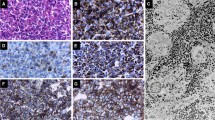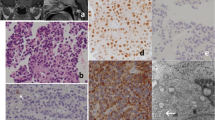Abstract
Little information is available regarding androgen receptor immunoexpression (AR) in the normal and neoplastic human pituitary. Available experimental data links it to primarily gonadotroph cells. We undertook an immunohistochemical study of 41 autopsy-derived normal glands from patients of both sexes and all ages as well as 79 fully characterized pituitary adenomas of all types, the focus being upon AR expression in normal and neoplastic gonadotrophs. Nuclear AR immunoreactivity was noted in gonadotrophs and other normal adeno- and neurohypophysial cells. In addition to its presence in 74% of gonadotroph and 55% of null cell adenomas, lesser proportions of other adenoma types (adrenocorticotropic hormone 50%, prolactin 38%, growth hormone 33%) also exhibited AR immunoreactivity. No staining of thyroid-stimulating hormone adenomas was noted. The physiologic significance of our findings remains to be explored. The literature regarding AR expression in animal and human pituitaries is reviewed.






Similar content being viewed by others
References
Bhuiyan MM, Li Y, Banerjee S, Ahmed F, Wang Z, Ali S, Sarkar FH. Down-regulation of androgen receptor by 3,3′-diindolylmethane contributes to inhibition of cell proliferation and induction of apoptosis in both hormone-sensitive LNCaP and insensitive C4–2B prostate cancer cells. Cancer Res. 2006;66(20):10064–72.
Gao S, Wang H, Lee P, Melamed J, Li CX, Zhang F, Wu H, Zhou L, Wang Z. Androgen receptor and prostate apoptosis response factor-4 target the c-FLIP gene to determine survival and apoptosis in the prostate gland. J Mol Endocrinol. 2006;36(3):463–83.
Tepper CG, Vinall RL, Wee CB, Xue L, Shi XB, Burich R, Mack PC, de Vere White RW. GCP-mediated growth inhibition and apoptosis of prostate cancer cells via androgen receptor-dependent and -independent mechanisms. Prostate. 2007;67(5):521–35.
Wu JD, Haugk K, Woodke L, Nelson P, Coleman I, Plymate SR. Interaction of IGF signaling and the androgen receptor in prostate cancer progression. J Cell Biochem. 2006;99(2):392–401.
Planz B, Wang Q, Kirley SD, Marberger M, McDougal WS. Regulation of keratinocyte growth factor receptor and androgen receptor in epithelial cells of the human prostate. J Urol. 2001;166 (2):678–83.
Rosini P, Bonaccorsi L, Baldi E, Chiasserini C, Forti G, De Chiara G, Lucibello M, Mongiat M, Iozzo RV, Garaci E, Cozzolino F, Torcia MG. Androgen receptor expression induces FGF2, FGF-binding protein production, and FGF2 release in prostate carcinoma cells: role of FGF2 in growth, survival, and androgen receptor down-modulation. Prostate. 2002;53(4):310–21.
Schafer W, Funke PJ, Kunde D, Rausch U, Wennemuth G, Stutzer H. Intensity of androgen and epidermal growth factor receptor immunoreactivity in samples of radical prostatectomy as prognostic indicator: correlation with clinical data of long-term observations. J Urol. 2006;176(2):532–37.
Kimura N, Mizokami A, Oonuma T, Sasano H, Nagura H. Immunocytochemical localization of androgen receptor with polyclonal antibody in paraffin-embedded human tissues. J Histochem Cytochem. 1993;41(5):671–78.
Gharib SD, Wierman ME, Shupnik MA, Chin WW. Molecular biology of the pituitary gonadotropins. Endocr Rev. 1990;11(1):177–99.
Wehrenberg WB, Giustina A. Basic counterpoint: mechanisms and pathways of gonadal steroid modulation of growth hormone secretion. Endocr Rev. 1992;13(2):299–308.
Lu S, Tsai SY, Tsai MJ. Regulation of androgen-dependent prostatic cancer cell growth: androgen regulation of CDK2, CDK4, and CKI p16 genes. Cancer Res. 1997;57(20):4511–16.
Wang PH, Chang C. Androgens and ovarian cancers. Eur J Gynaecol Oncol. 2004;25(2):157–63.
Brys M, Semczuk A, Baranowski W, Jakowicki J, Krajewska WM. Androgen receptor (AR) expression in normal and cancerous human endometrial tissues detected by RT-PCR and immunohistochemistry. Anticancer Res. 2002;22(2A):1025–31.
Moinfar F, Regitnig P, Tabrizi AD, Denk H, Tavassoli FA. Expression of androgen receptors in benign and malignant endometrial stromal neoplasms. Virchows Arch. 2004;444(5):410–14.
Carroll RS, Zhang J, Dashner K, Sar M, Wilson EM, Black PM. Androgen receptor expression in meningiomas. J Neurosurg. 1995;82(3):453–60.
Weisenberg LS, Piroli G, Heller CL, De Nicola AF. Binding of steroids in nuclear extracts and cytosol of rat pituitary and estrogen-induced pituitary tumors. J Steroid Biochem. 1987;28(6):683–89.
Jaffrain-Rea ML, Petrangeli E, Ortolani F, Fraioli B, Lise A, Esposito V, Spagnoli LG, Tamburrano G, Frati L, Gulino A. Cellular receptors for sex steroids in human pituitary adenomas. J Endocrinol. 1996;151(2):175–84.
Caronti B, Palladini G, Calderaro C, Bevilacqua MG, Petrangeli E, Esposito V, Tamburrano G, Gulino A, Jaffrain-Rea ML. Effects of gonadal steroids on the growth of human pituitary adenomas in vitro. Tumour Biol. 1995;16(6):353–64.
Saeger W, Schreiber S, Ludecke DK. Androgen receptor in pituitary adenomas of the gonadotroph cell complex. Pathol Res Pract. 2000;196(11):771–73.
Babichev VN, Marova EI, Kuznetsova TA, Adamskaya EI, Shishkina IV, YuK S. Role of sex hormones in development of pituitary adenoma. Bull Exp Biol Med. 2001;131(4):309–11.
Asa SL. Tumors of the pituitary gland. In: Rosai J, editor. Atlas of tumor pathology, 3rd series, fascicle 22. Washington, DC: Armed Forces Institute of Pathology; 1998; p 1–210.
Choate JV, Slayden OD, Resko JA. Immunocytochemical localization of androgen receptors in brains of developing and adult male rhesus monkeys. Endocrine. 1998;8(1):51–60.
Woods JE, Blandin CM, Thommes RC. Ontogeny of immunocytochemically demonstrable androgen- and androgen receptor-containing cells in the hypothalamus and adenohypophysis of the chick embryo. Growth Dev Aging. 1994;58(1):21–31.
Okada Y, Fujii Y, Moore JP, Jr., Winters SJ. Androgen receptors in gonadotrophs in pituitary cultures from adult male monkeys and rats. Endocrinology. 2003;144(1):267–73.
Prior JC, Cox TA, Fairholm D, Kostashuk E, Nugent R. Testosterone-related exacerbation of a prolactin-producing macroadenoma: possible role for estrogen. J Clin Endocrinol Metab. 1987;64(2):391–94.
Lopes MBS, Thapar K, Horvath E, Kovacs K. Neoplasms of the sellar region (chap 54). In: McLendon RE, Rosenblum MK, Bigner DD, editors. Russell and Rubinstein’s pathology of tumors of the nervous system, 7th edn. New York, NY: Hodder Arnold; 2006. p. 740–741.
DonCarlos LL, Sarkey S, Lorenz B, Azcoitia I, Garcia-Ovejero D, Huppenbauer C, Garcia-Segura LM. Novel cellular phenotypes and subcellular sites for androgen action in the forebrain. Neuroscience. 2006;138(3):801–807.
Lorenz B, Garcia-Segura LM, DonCarlos LL. Cellular phenotype of androgen receptor-immunoreactive nuclei in the developing and adult rat brain. J Comp Neurol. 2005;492(4):456–68.
Garcia-Ovejero D, Veiga S, Garcia-Segura LM, Doncarlos LL. Glial expression of estrogen and androgen receptors after rat brain injury. J Comp Neurol. 2002;450(3):256–71.
Hosli E, Jurasin K, Ruhl W, Luthy R, Hosli L. Colocalization of androgen, estrogen and cholinergic receptors on cultured astrocytes of rat central nervous system. Int J Dev Neurosci. 2001;19(1):11–19.
Puy L, MacLusky NJ, Becker L, Karsan N, Trachtenberg J, Brown TJ. Immunocytochemical detection of androgen receptor in human temporal cortex characterization and application of polyclonal androgen receptor antibodies in frozen and paraffin-embedded tissues. J Steroid Biochem Mol Biol. 1995;55(2):197–209.
Verzat C, Delisle MB, Courriere P, Hollande E. Influence of host sex on the growth of a human glioblastoma line in athymic mice. Neuropathol Appl Neurobiol. 1990;16(2):141–51.
Huang X, Harlan RE. Androgen receptor immunoreactivity in somatostatin neurons of the periventricular nucleus but not in the bed nucleus of the stria terminalis in male rats. Brain Res. 1994;652(2):291–96.
Bittman EL, Ehrlich DA, Ogdahl JL, Jetton AE. Photoperiod and testosterone regulate androgen receptor immunostaining in the Siberian hamster brain. Biol Reprod. 2003;69(3):876–84.
Iqbal J, Swanson JJ, Prins GS, Jacobson CD. Androgen receptor-like immunoreactivity in the Brazilian opossum brain and pituitary: distribution and effects of castration and testosterone replacement in the adult male. Brain Res. 1995;703(1–2):1–18.
Herbison AE. Neurochemical identity of neurones expressing oestrogen and androgen receptors in sheep hypothalamus. J Reprod Fertil Suppl. 1995;49:271–83.
Wu SS, Nathanielsz PW, McDonald TJ. Immunocytochemical distribution of androgen receptors in the hypothalamus and pituitary of the fetal baboon in late gestation. Dev Brain Res. 1995;84(2):278–81.
Sar M, Stumpf WE. Distribution of androgen target cells in rat forebrain and pituitary after [3H]-dihydrotestosterone administration. J Steroid Biochem. 1977;8(11):1131–35.
Thieulant ML, Duval J. Differential distribution of androgen and estrogen receptors in rat pituitary cell populations separated by centrifugal elutriation. Endocrinology. 1985;116(4):1299–303.
Console GG, Rulli SB, Riccillo FL, Calandra RS, Gomez Dumm CL. Effects of androgens and antiandrogens on the quantitative immunohistochemistry of gonadotrope cells in prepubertal male rats. Neuroendocrinology. 1999;70(4):261–67.
Takeda H, Chodak G, Mutchnik S, Nakamoto T, Chang C. Immunohistochemical localization of androgen receptors with mono- and polyclonal antibodies to androgen receptor. J Endocrinol. 1990;126(1):17–25.
Acknowledgments
The authors would like to thank Mr. James Hopfenspirger for his photographic expertise and Mrs. Denise Chase for excellent secretarial support.
Author information
Authors and Affiliations
Corresponding author
Rights and permissions
About this article
Cite this article
Scheithauer, B.W., Kovacs, K., Zorludemir, S. et al. Immunoexpression of Androgen Receptor in the Nontumorous Pituitary and in Adenomas. Endocr Pathol 19, 27–33 (2008). https://doi.org/10.1007/s12022-007-9012-0
Published:
Issue Date:
DOI: https://doi.org/10.1007/s12022-007-9012-0




